UFR 4-18 Evaluation
Flow and heat transfer in a pin-fin array
Confined Flows
Underlying Flow Regime 4-18
Evaluation
Comparison of CFD Calculations with Experiments
Discuss how well the CFD calculations of the assessment quantities
compare with experiment and with one another. Present some key
comparisons in the form of tables or graphical plots and, where
possible, provide hyperlinks to the appropriate results database.
Results with different turbulence models covering as wide a range as
possible should be included in the discussion. However, if too many
different calculation results are available (e.g. from workshops) do
not present all the comparisons here. A selection should be made
showing results only for the most typical and practically important
models. Comprehensive comparisons can be made available via a link to
the associated databases. Finally, draw conclusions on the ability of
the models used to simulate the test case flow.
Global comparisons
Pressure loss coefficient
The following table gives the numerical values of the presure loss coefficient in Ames et al. experiment as well as those obtained in the main computations.
Figure ?? shows these values and compare them to existing correlations from the literature:
- Metzger et al. (1982) :
for , Failed to parse (syntax error): {\displaystyle f = 0.317 {Re_D}^{−0.132} } , for , Failed to parse (syntax error): {\displaystyle f = 1.76 {Re_D}^{−0.318}}
- Jacob (1938) :
Large Eddy Simulation shows a very good agreement with the correlations and Ames et al. experimental results. The relative error is equal to 1% end 3% for the two Reynolds numbers, respectively. for both computed Reynolds numbers. The EB-RSM shows a very satisfactory pressure loss coefficient at (1% error) but a worse pressure loss coefficient at (10% error). The kω-SST shows globally good results (7% and 6% errors) and the φ-model poorer results with an error of 17% and 12% for the two Reynolds numbers, respectively.
Wall resolved LES is then the best candidate to obtain almost perfect pressure loss coefficients in the present configuration. The EB-RSM five very good results at the lowest Reynolds number but a substantial error is observed at . Although the kω-SST exhibits pretty good results, the physics of the present flow is not well captured and one can't rely on this model. The φ-model has to be avoided for the present configuration in order to compute the pressure loss coefficient.
| Ames et al. | LES3000 | Ames et al. | LES10000 | EBRSM10000 | PHI10000 | kwSST10000 | Ames et al. | EBRSM30000 | PHI30000 | kwSST30000 | |
|---|---|---|---|---|---|---|---|---|---|---|---|
| Value | 0.111 | 0.1076 | 0.095 | 0.0939 | 0.0963 | 0.0789 | 0.0883 | 0.07 | 0.0771 | 0.0615 | 0.0744 |
| Error (%) | - | 3 | - | 1 | 1 | 17 | 7 | - | 10 | 12 | 6 |
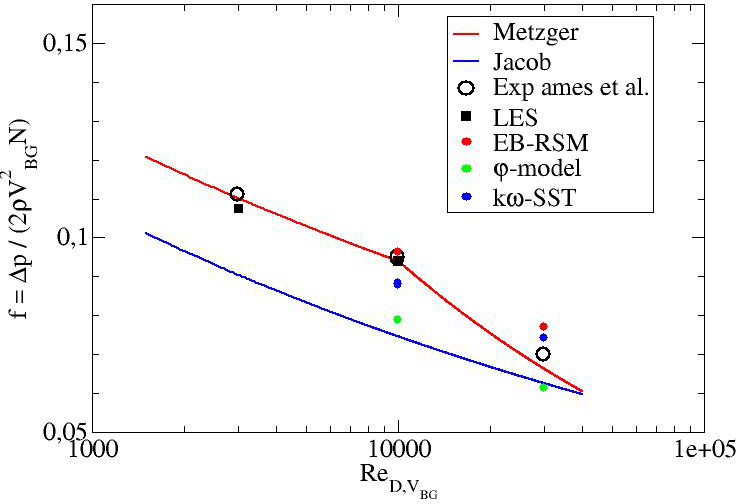
Figure ??: Pressure loss coefficient
Average Nusselt Number
The following table gives the numerical values of the average Nusselt numbers in Ames et al. experiment as well as those obtained in the main computations.
Figure ?? shows these values and compare them to existing correlations from the literature:
- Metzger et al. (1982) :
- Van Fossen (1982) :
Note that the experimental results have an error of +/- 12%, +/-11.4%, and +/-10.5% for the 3 000, 10 000, and 30 000 Reynolds numbers, respectively, in the endwall regions adjacent to the pins and +/- 9% away from the pin.
One can see that the two models using a first moment closure (φ-model and kω-SST) are too far from the experimental results, except the φ-model at but which, as it will be shown later exhibits a wrong physics. LES and EB-RSM exhibits very satisfactory values in the error interval. The superiority of these two models will be discussed later while dealing with the local normalized Nusselt number on the bottom wall. Ames and Dvorak (2006a) used standard, Realizable and RNG k-ε models in Fluent commercial software. They showed a substantial underestimation of the averaged Nusselt number when the pins were heated. Delibra et al. (2009) used the URANS ζ-f model (very close to the &phi-model utilized in the present work) at the 10000 and 30000 Reynolds numbers. They obtained averaged Nusselt numbers of 46.2 and 122.3, respectively. These values are higher than those obtained in the present work and closer to experimental values.The temperature was imposed at the wall in Delibra et al. (2009). Imposing the temperature at the wall led to averaged Nusselt numbers of 41 and 100, respectively, with the &phi-model. This shows that imposing the temperature gives higher Nusselt numbers that by imposing the heat flux with this model. The effect of the temperature boundary condition has also been tested with the LES at and the EB-RSM at . The averaged Nusselt numbers were equal to 46 and 115.6, respectively. No clear conclusion can be drawn for these two models which give a more realistic physics than the models using a first moment closure concerning the effect of imposing the temperature instead of the heat flux at the bottom wall. However, one can state that there is a difference between the two methods. Delibra et al. (2008) also reported LES computations. The one used for was too coarse with a short time integration and will not be considered here. LES at gave an average Nusselt number equal to 44.3 which is lower than the one obtained in the present work even with a fixed temperature at the wall. The error compared to the experimental value is equal to 18% which is too high. This discrepancy can be attributed to two factors:
- the mesh was probably still too coarse, not in the wall normal directions but in the stream-wise and span-wise ones (the mesh in the present study contains 76 million cells and their mesh contained 5.5 million cells),
- the boundary condition using an imposed temperature is less representative of the experiment.
Finally, Delibra et al. (2010) tried to use a hybrid RANS/LES approach to overcome the understimation of the Nusselt number but the results where close to the ones obtained with the URANS approach based on the ζ-f model.
| Ames et al. 3000 | LES3000 | Ames et al. 10000 | LES10000 | EBRSM10000 | PHI10000 | kwSST10000 | Ames et al. 30000 | EBRSM30000 | PHI30000 | kwSST30000 | |
|---|---|---|---|---|---|---|---|---|---|---|---|
| Value | 22.1 | 21.6 | 54.1 | 48.6 | 48.1 | 37.6 | 33.1 | 111.5 | 114.8 | 93.3 | 72 |
| Error (%) | - | 2 | - | 10 | 11 | 30 | 39 | - | 3 | 16 | 35 |

Figure ??: Averaged Nusselt number on the bottom wall
Local comparisons
Mean pressure coefficient
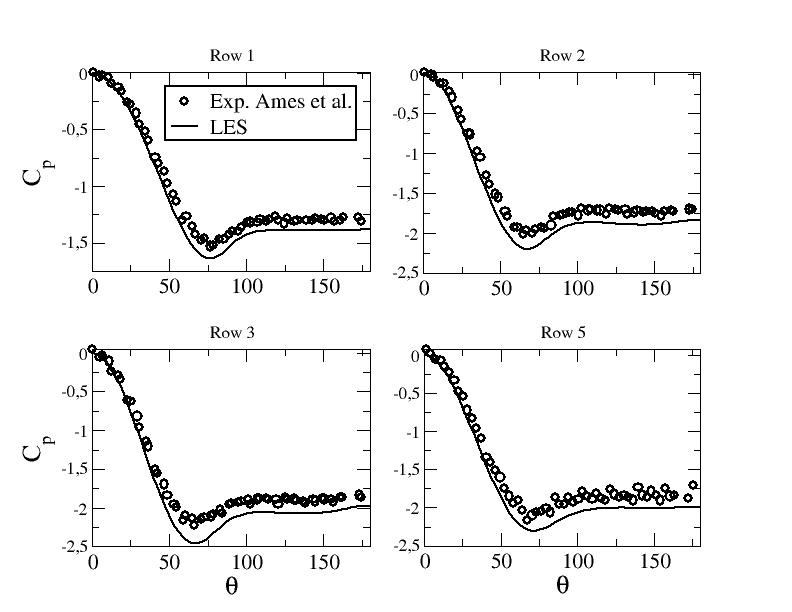
Figure ??: Pressure coefficient along the midline of the pins - LES at

Figure ??: Pressure coefficient along the midline of the pins - LES and URANS computations at

Figure ??: Pressure coefficient along the midline of the pins - URANS computations at
Mean velocity profiles
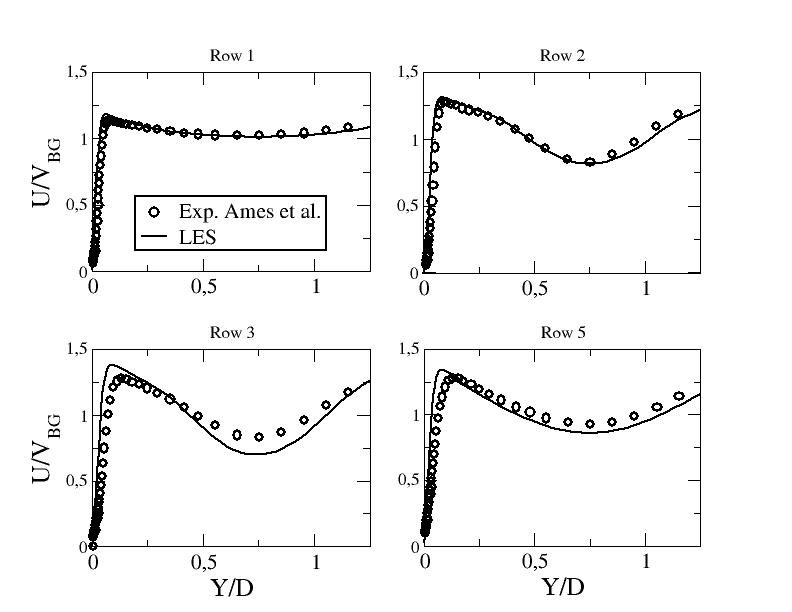
Figure ??: Mean stream-wse velocity component along line B - LES at

Figure ??: Mean stream-wse velocity component along line B - LES and URANS computations at
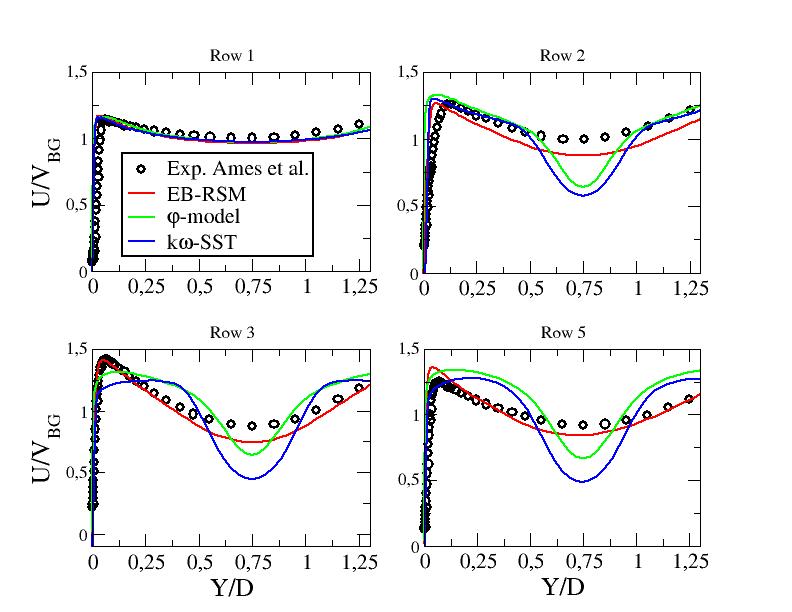
Figure ??: Mean stream-wse velocity component along line B - URANS computations at

Figure ??: Mean stream-wse velocity component along line A1 - URANS computations at
R.m.s. velocity profiles

Figure ??: R.m.s. of the stream-wise velocity component along line B - LES at

Figure ??: R.m.s. of the stream-wise velocity component along line B - LES and URANS computations at

Figure ??: Resolved and modelled contributions to the r.m.s. of the stream-wise velocity component along line B - URANS computations at

Figure ??: R.m.s. of the stream-wise velocity component along line B - URANS computations at

Figure ??: Resolved and modelled contributions to the r.m.s. of the stream-wise velocity component along line B - URANS computations at

Figure ??: R.m.s. of the stream-wise velocity component along line A1 - URANS computations at

Figure ??: Resolved and modelled contributions to the r.m.s. of the stream-wise velocity component along line A1 - URANS computations at
Nusselt number on the bottom wall

Figure ??: Local Nusselt number on the bottom wall - LES computation at vs. experimental results from Ames et al.
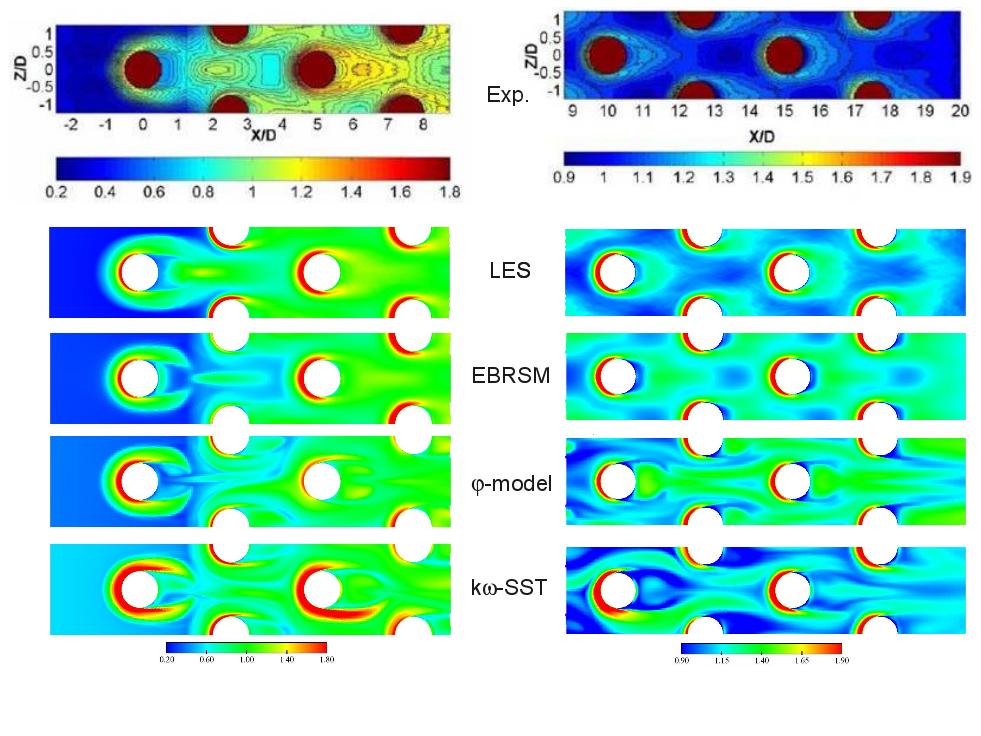
Figure ??: Local Nusselt number on the bottom wall - LES and URANS computations at vs. experimental results from Ames et al.
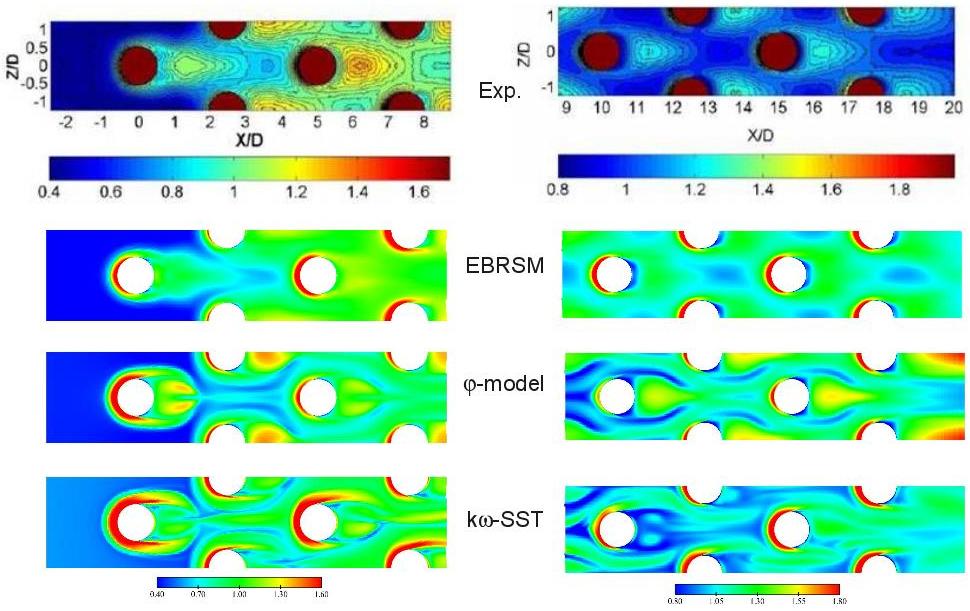
Figure ??: Local Nusselt number on the bottom wall - URANS computations at vs. experimental results from Ames et al.

Figure ??: Local Nusselt number on the bottom wall - - top: Y=0, bottom: Y=1.25 - symb.: Exp. - black: LES
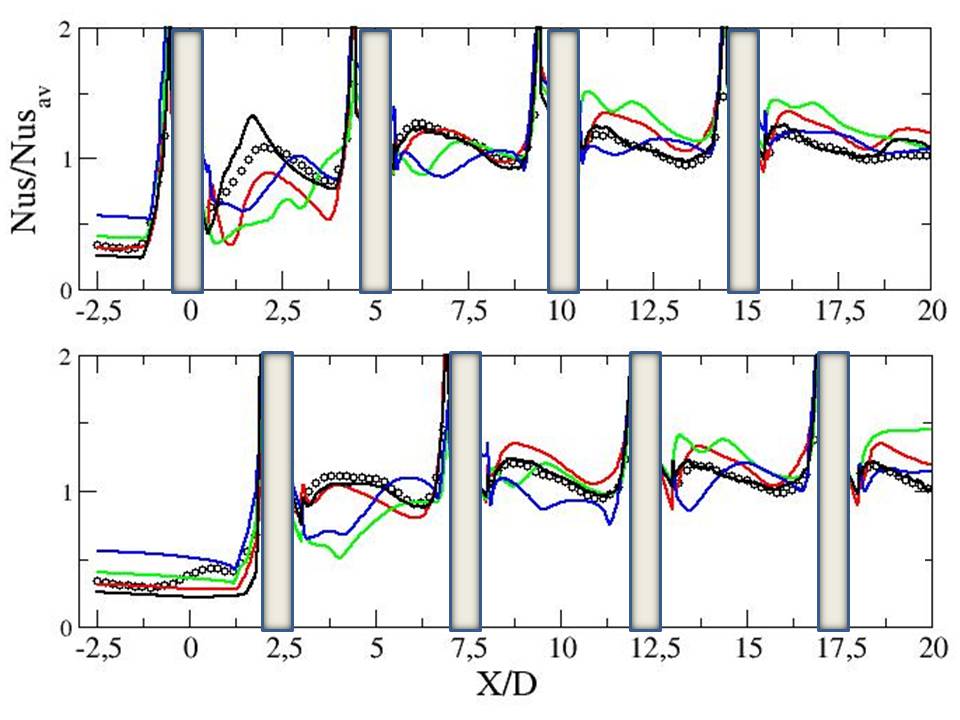
Figure ??: Local Nusselt number on the bottom wall - - top: Y=0, bottom: Y=1.25 - symb.: Exp. - black: LES - red: EBRSM - blue: Phi-model - green: kw-SST

Figure ??: Local Nusselt number on the bottom wall - - top: Y=0, bottom: Y=1.25 - symb.: Exp. - red: EBRSM - blue: Phi-model - green: kw-SST
Contributed by: Sofiane Benhamadouche — EDF
© copyright ERCOFTAC 2024







